Not a better titled comic this year.
Little Fluffy Gigolo PELU Vol. 1
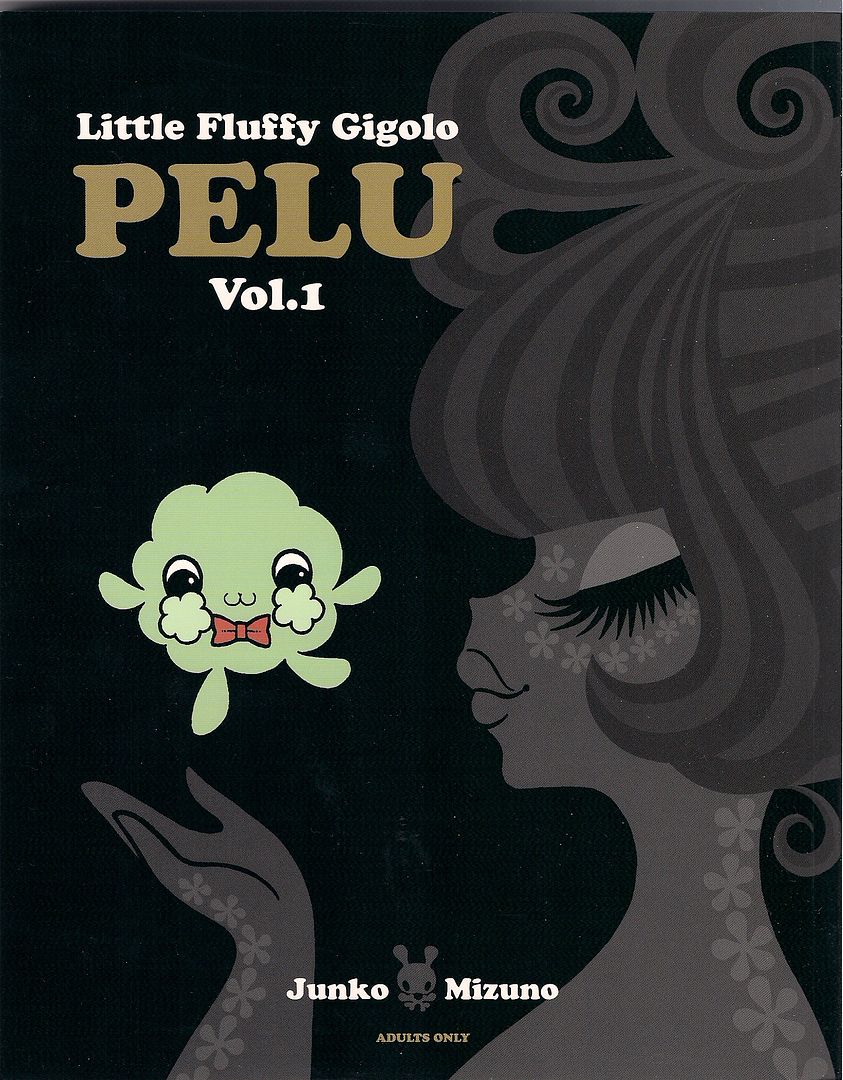
Yes, PELU is ALL CAPS in the legal indicia, even though its traditionally capitalized as a character's name in the book itself. It just adds to the excitement, doesn't it? Makes you want to shout it. There's a theme song too, with different lyrics for each chapter. It's one of those comics.
More specifically, it's a Junko Mizuno comic. Some readers might recognize her work from a trio of strange fairy tale adaptations VIZ released in 2002 and 2003 -- Cinderalla (no, I spelled it right), Hansel and Gretel and Princess Mermaid -- although devotees could go all the way back to 2000's Secret Comics Japan anthology, released only four years after the artist's comics debut in the dōjinshi MINA animal DX, which was sold out of a fashion outlet in Harajuku. Her initial pro comics appeared in a music magazine, H, and her first longform work, Pure Trance, was initially serialized across 10 booklets included with techno CDs. Last Gasp brought that work to English in 2005; this marks their second outing with the artist.
And you might be forgiven for glancing over Mizuno's work and deeming it primarily illustrative, with self-contained pages-as-designs blending archly poised 'cute' iconography with anatomical frankness and steady-leaking gore, candied colors optional. She was an illustrator before she became a cartoonist, after all, and her background is heavily steeped in music and design, rather than the apprenticeships or contest victories or Comiket arrivals common to a young person's development into a mangaka.
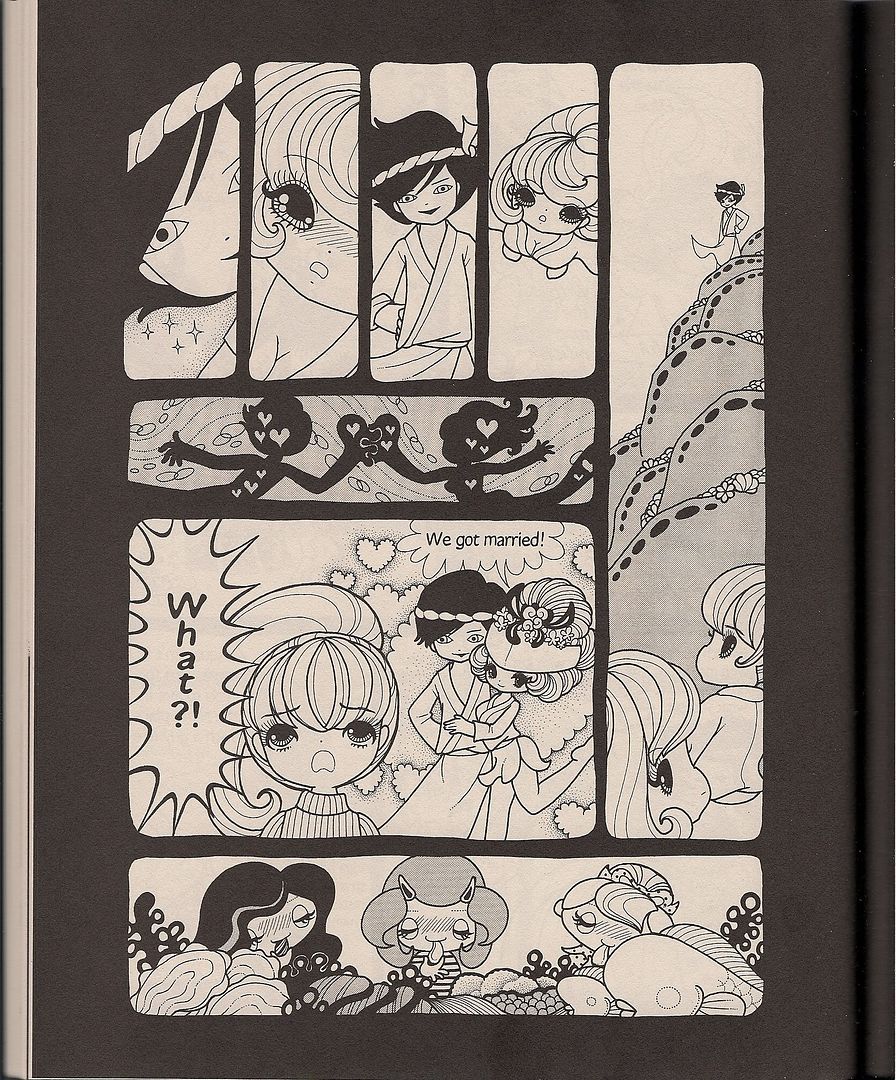
(right to left, note)
That wouldn't be totally accurate, though - Mizuno knows manga, and from a remarkably classical standpoint. Her childhood coincided with the legendary '70s golden age of shōjo manga, although it's telling that she cites Kazuo Umezu's girls' comics period from the decade prior as her childhood favorite; very little of the revolutionary influence of the Year 24 Group -- their visual abstractions and layout explosions and emotions sizzling corporeally -- can be detected in her work.
Rather, it's the older, primal shōjo that holds court, the Osamu Tezuka of Princess Knight spilling into the anime prettiness of Sailor Moon (another avowed favorite). Her limber little characters romp around the page or stand and pose, brightly, with incredible energy building from these cartoon antics melded to the artist's aforementioned design sense. There's some furious drawing going in this book in particular, maybe inspired by Mizuno's adherence to old fashioned square and rectangle panels, tightly arranged. Maybe not as tightly as Umezu would wind it, but your eyes just fly nonetheless.
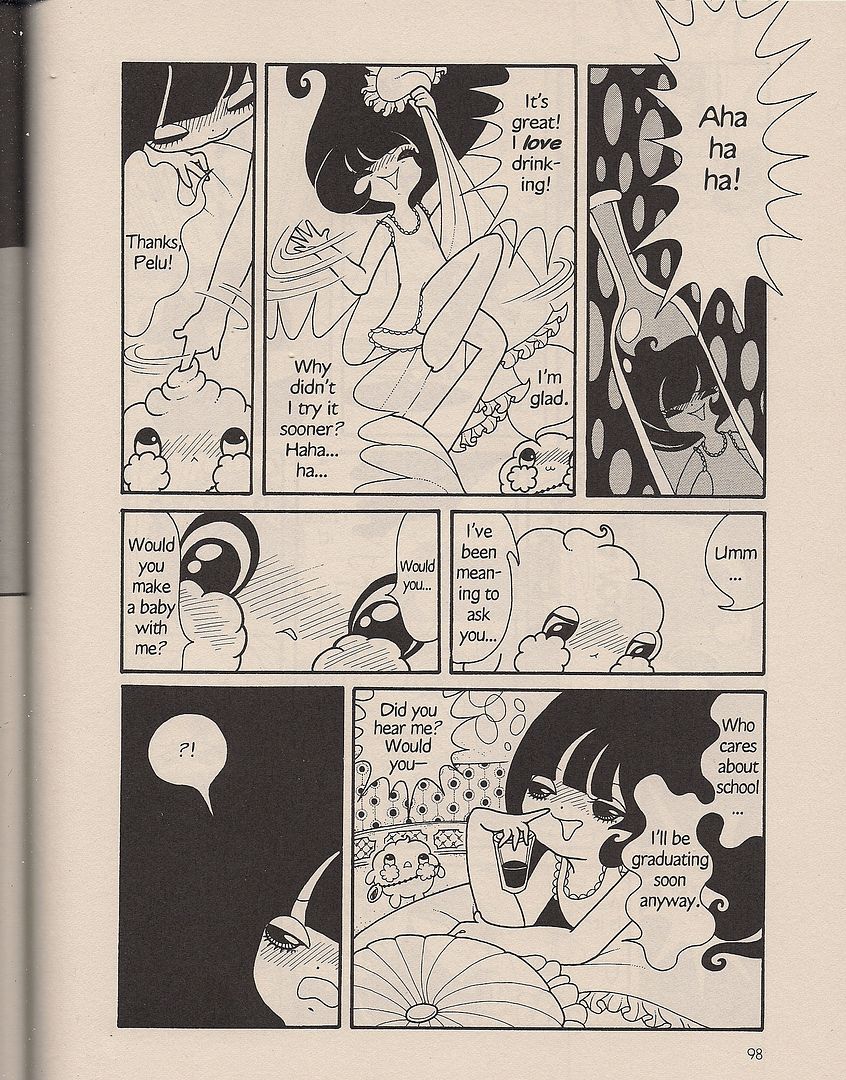
Moreover, Mizuno's approach feeds her storytelling obsessions: beauty, bodies, food, belonging, and relationships that veer between devoutly close and doomed to work at cross-purposes. Even her four-pager from last week's Strange Tales #1 saw all of these elements at work
Every woman is cute and sprightly and pixied, and often naked - all the better to meld prettiness with vulnerability. The only distinction between young and old in this book is how thick the women seem compared to the girls. The men, in contrast, are squat and beady, the beautiful ones often ironically so. They vary visually in a way Mizuno's women don't, although there's obviously different personalities at hand; femininity is a shared thing in this artist's world, and women are thereby troubled by the same pressures, the same image issues, the same sex issues, the same anxieties.
It's also basically comedic, sometimes due to the disconnect between the sparkly sights on display and some grim added element, be it written in or just somewhere present in the frames: little gothy skulls, boys huffing solvents or bandages covering dolly legs as their owner strikes poses seemingly ripped from a library of archetypical manga girl images, so charged with such direct emotional meaning the potential banality of the contrast instead becomes affecting, because she's going right down to some heart of the art, the building blocks of a tradition of girl stories. If all these women look young, it's only from Mizuno wielding the stuff of a young art, unadorned, all passion. But she deals with it like an adult; that's what she is.
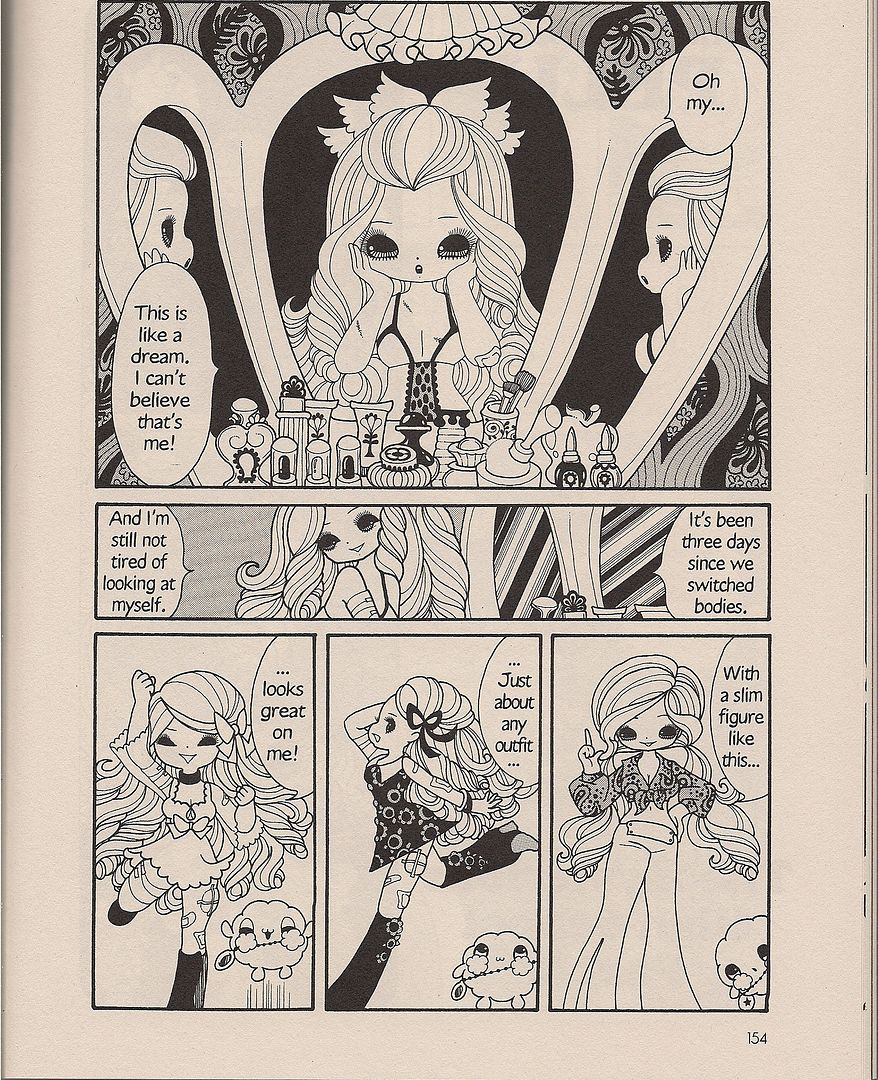
Little Fluffy Gigolo PELU is a good place to see all of this in action, since it's Mizuno's first (and as far as I know only) experience with an ongoing series, told in chapters with recurring characters and a big concept: the quest of lil' furry Pelu to find a human woman to make a baby with so he can return to his home planet of Princess Kotobuki without feeling so inadequate.
The book's kickoff chapter tells Our Man's origin, a hallucinatory burlesque on girlish terror/excitement of giving birth in which an all-nude civilization of humanoid girls learn from their elders that tiny male and female fluffballs are growing in their bellies, only to eventually have sex (whatever that is) and make babies pop out without the knowlege or consent of the host. Pelu is a fluffball that survived in the wild after his girl host was tragically eaten by the local Space Hippo, which itself was then struck by lightning before it could quite finish. As you'd expect, upon learning this secret news Pelu leaps into since recovered Space Hippo's magic mirror to enter modern Japan and make a baby of his own (however that's done).
This first volume was published in Japan in 2003; two more books followed in '04 and '05, though I don't know if that wrapped the series. I suspect they'll follow the pattern set by the rest of vol. 1: meek, none-too-bright Pelu shacks up with a human female -- he's a gigolo in the 'mooching off of women' sense -- who's troubled by some struggle that causes her to doubt who she is. There's a newly pregnant woman whose boyfriend pushes her to chase her dreams of singing, a schoolgirl who tells lies and longs for the attentions of her working mother and shitty boy crush, a fish diving pro whose world is disturbed when her shy sister marries a lusty sushi chef with robot arms, and a plain girl who finds herself switching bodies with a local beauty with big issues.
Pelu witnesses most of this, and never gets laid. Actually, he often fails to even comprehend what's going on, though he's sometimes an accidental catalyst to get things happening. That's part of the point: Pelu is only the most extreme of Mizuno's contorted men -- although his awesomely filthy human bum friend Su-san comes close, with whiskers drawn by simply circling his mouth over and over and over with pen -- while the women he visits suffer through their personal dramas, the real focus of Mizuno's art.
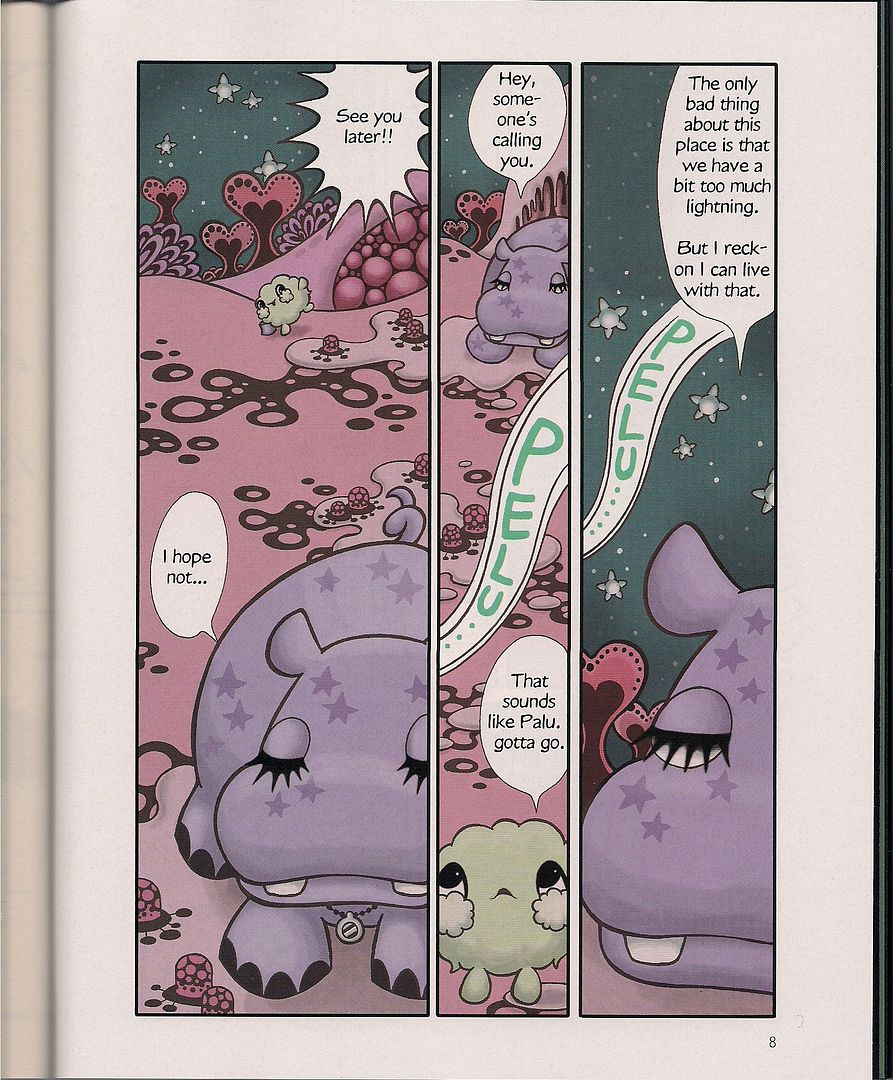
(yep, the first few pages are color)
And they're fast, effective little tales, even if Mizuno is probably a better writer of character moments and crazed set pieces than whole plots. Of the four stories, two of them eventually boil down to fairly basic ' careful what you wish for!' scenarios, with the body-swapping number in particular degenerating into horror spoof chaos as the newly hot heroine discovers the psycho status of her body's ex-owner's boyfriend (which frankly speaks more to bad taste in guys than the perils of fretting over physical beauty). Mizuno is generally better when her gags are guided by some emotional or thematic charge; she's not above lapsing into 'edgy' cute cliché, whereby the first mention of a herd of floofy poodles in teensy lil' sweaters removes any doubt as to a horrible horrible fate in store.
But she lands her characterizations with confidence, perfectly capturing the casual cruelty of a hurt young girl longing to feel superior to something in her life, or the slow burn of a woman secretly terrified that her outgoing sister will steal the man she finally fell for, particularly after she gets -- eek! -- pregnant. If the artist's female bodies seem always poised or running or capering, it's because her interest here is in the changes a body has to undergo from female biological processes, as well as the changes it could undergo from outside pressure or personal worry. Giving birth is the most extreme iteration of this theme, and it marks tiny Pelu's misunderstanding of the world of women: it's something he wants for himself, though he doesn't understand how it affects others in a more profound way.
Maybe he'll learn. Mizuno is also a hopeful artist, refusing to leave any of her short-time protagonists without a few embers of hope burning for a better life. They all become a little more honest about what they want, or at least more aware of their problems. A little calmer too, often settling back into family life, or hoping for something like that. It's a bit of a conservative work in that way, much like how Mizuno's layouts hail from a more restrained time. Yet her sights are odd and pulsing enough you'll believe it sat next to new club beats - there's anti-drug messages in here, yet one of its most excellent scenes has two girls and a horde of bunnies getting cranked on special pills.
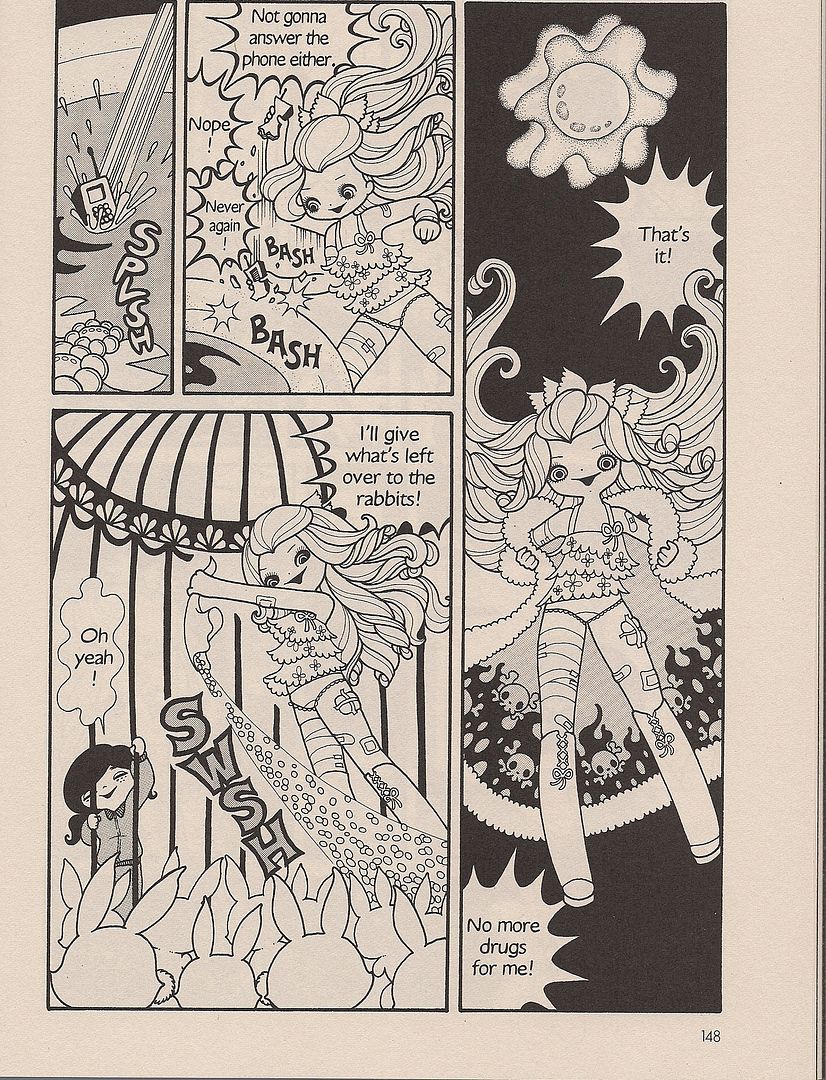
That's Mizuno in a nutshell. Sharp enough to know the trouble behind all this, but not about to deny the pleasure of the moment.

Yes, PELU is ALL CAPS in the legal indicia, even though its traditionally capitalized as a character's name in the book itself. It just adds to the excitement, doesn't it? Makes you want to shout it. There's a theme song too, with different lyrics for each chapter. It's one of those comics.
More specifically, it's a Junko Mizuno comic. Some readers might recognize her work from a trio of strange fairy tale adaptations VIZ released in 2002 and 2003 -- Cinderalla (no, I spelled it right), Hansel and Gretel and Princess Mermaid -- although devotees could go all the way back to 2000's Secret Comics Japan anthology, released only four years after the artist's comics debut in the dōjinshi MINA animal DX, which was sold out of a fashion outlet in Harajuku. Her initial pro comics appeared in a music magazine, H, and her first longform work, Pure Trance, was initially serialized across 10 booklets included with techno CDs. Last Gasp brought that work to English in 2005; this marks their second outing with the artist.
And you might be forgiven for glancing over Mizuno's work and deeming it primarily illustrative, with self-contained pages-as-designs blending archly poised 'cute' iconography with anatomical frankness and steady-leaking gore, candied colors optional. She was an illustrator before she became a cartoonist, after all, and her background is heavily steeped in music and design, rather than the apprenticeships or contest victories or Comiket arrivals common to a young person's development into a mangaka.

(right to left, note)
That wouldn't be totally accurate, though - Mizuno knows manga, and from a remarkably classical standpoint. Her childhood coincided with the legendary '70s golden age of shōjo manga, although it's telling that she cites Kazuo Umezu's girls' comics period from the decade prior as her childhood favorite; very little of the revolutionary influence of the Year 24 Group -- their visual abstractions and layout explosions and emotions sizzling corporeally -- can be detected in her work.
Rather, it's the older, primal shōjo that holds court, the Osamu Tezuka of Princess Knight spilling into the anime prettiness of Sailor Moon (another avowed favorite). Her limber little characters romp around the page or stand and pose, brightly, with incredible energy building from these cartoon antics melded to the artist's aforementioned design sense. There's some furious drawing going in this book in particular, maybe inspired by Mizuno's adherence to old fashioned square and rectangle panels, tightly arranged. Maybe not as tightly as Umezu would wind it, but your eyes just fly nonetheless.

Moreover, Mizuno's approach feeds her storytelling obsessions: beauty, bodies, food, belonging, and relationships that veer between devoutly close and doomed to work at cross-purposes. Even her four-pager from last week's Strange Tales #1 saw all of these elements at work
Every woman is cute and sprightly and pixied, and often naked - all the better to meld prettiness with vulnerability. The only distinction between young and old in this book is how thick the women seem compared to the girls. The men, in contrast, are squat and beady, the beautiful ones often ironically so. They vary visually in a way Mizuno's women don't, although there's obviously different personalities at hand; femininity is a shared thing in this artist's world, and women are thereby troubled by the same pressures, the same image issues, the same sex issues, the same anxieties.
It's also basically comedic, sometimes due to the disconnect between the sparkly sights on display and some grim added element, be it written in or just somewhere present in the frames: little gothy skulls, boys huffing solvents or bandages covering dolly legs as their owner strikes poses seemingly ripped from a library of archetypical manga girl images, so charged with such direct emotional meaning the potential banality of the contrast instead becomes affecting, because she's going right down to some heart of the art, the building blocks of a tradition of girl stories. If all these women look young, it's only from Mizuno wielding the stuff of a young art, unadorned, all passion. But she deals with it like an adult; that's what she is.

Little Fluffy Gigolo PELU is a good place to see all of this in action, since it's Mizuno's first (and as far as I know only) experience with an ongoing series, told in chapters with recurring characters and a big concept: the quest of lil' furry Pelu to find a human woman to make a baby with so he can return to his home planet of Princess Kotobuki without feeling so inadequate.
The book's kickoff chapter tells Our Man's origin, a hallucinatory burlesque on girlish terror/excitement of giving birth in which an all-nude civilization of humanoid girls learn from their elders that tiny male and female fluffballs are growing in their bellies, only to eventually have sex (whatever that is) and make babies pop out without the knowlege or consent of the host. Pelu is a fluffball that survived in the wild after his girl host was tragically eaten by the local Space Hippo, which itself was then struck by lightning before it could quite finish. As you'd expect, upon learning this secret news Pelu leaps into since recovered Space Hippo's magic mirror to enter modern Japan and make a baby of his own (however that's done).
This first volume was published in Japan in 2003; two more books followed in '04 and '05, though I don't know if that wrapped the series. I suspect they'll follow the pattern set by the rest of vol. 1: meek, none-too-bright Pelu shacks up with a human female -- he's a gigolo in the 'mooching off of women' sense -- who's troubled by some struggle that causes her to doubt who she is. There's a newly pregnant woman whose boyfriend pushes her to chase her dreams of singing, a schoolgirl who tells lies and longs for the attentions of her working mother and shitty boy crush, a fish diving pro whose world is disturbed when her shy sister marries a lusty sushi chef with robot arms, and a plain girl who finds herself switching bodies with a local beauty with big issues.
Pelu witnesses most of this, and never gets laid. Actually, he often fails to even comprehend what's going on, though he's sometimes an accidental catalyst to get things happening. That's part of the point: Pelu is only the most extreme of Mizuno's contorted men -- although his awesomely filthy human bum friend Su-san comes close, with whiskers drawn by simply circling his mouth over and over and over with pen -- while the women he visits suffer through their personal dramas, the real focus of Mizuno's art.

(yep, the first few pages are color)
And they're fast, effective little tales, even if Mizuno is probably a better writer of character moments and crazed set pieces than whole plots. Of the four stories, two of them eventually boil down to fairly basic ' careful what you wish for!' scenarios, with the body-swapping number in particular degenerating into horror spoof chaos as the newly hot heroine discovers the psycho status of her body's ex-owner's boyfriend (which frankly speaks more to bad taste in guys than the perils of fretting over physical beauty). Mizuno is generally better when her gags are guided by some emotional or thematic charge; she's not above lapsing into 'edgy' cute cliché, whereby the first mention of a herd of floofy poodles in teensy lil' sweaters removes any doubt as to a horrible horrible fate in store.
But she lands her characterizations with confidence, perfectly capturing the casual cruelty of a hurt young girl longing to feel superior to something in her life, or the slow burn of a woman secretly terrified that her outgoing sister will steal the man she finally fell for, particularly after she gets -- eek! -- pregnant. If the artist's female bodies seem always poised or running or capering, it's because her interest here is in the changes a body has to undergo from female biological processes, as well as the changes it could undergo from outside pressure or personal worry. Giving birth is the most extreme iteration of this theme, and it marks tiny Pelu's misunderstanding of the world of women: it's something he wants for himself, though he doesn't understand how it affects others in a more profound way.
Maybe he'll learn. Mizuno is also a hopeful artist, refusing to leave any of her short-time protagonists without a few embers of hope burning for a better life. They all become a little more honest about what they want, or at least more aware of their problems. A little calmer too, often settling back into family life, or hoping for something like that. It's a bit of a conservative work in that way, much like how Mizuno's layouts hail from a more restrained time. Yet her sights are odd and pulsing enough you'll believe it sat next to new club beats - there's anti-drug messages in here, yet one of its most excellent scenes has two girls and a horde of bunnies getting cranked on special pills.

That's Mizuno in a nutshell. Sharp enough to know the trouble behind all this, but not about to deny the pleasure of the moment.

<< Home